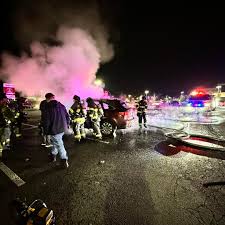Introduction to the Fairmount Target Fire
In recent events, the Fairmount Target fire has captured widespread attention due to its significant impact and dramatic unfolding. Understanding what happened during this fire, the extent of the damage, and the aftermath can provide valuable insights into the incident and its broader implications.
What Happened During the Fire?
On a seemingly ordinary day, the Fairmount Target store was engulfed in a severe fire that quickly became a major local news story. The blaze, which started under uncertain circumstances, rapidly spread through the store, causing extensive damage. Witnesses reported seeing thick smoke and flames erupting from the building, leading to a swift emergency response.
Location and Date of the Incident
The fire occurred at the Fairmount Target store, located in [City/State], on [Date]. This location was not only a crucial retail hub but also a significant part of the local community. The date of the incident marked a turning point, as it led to widespread concern and a coordinated response from various sectors.
Background Information
Overview of the Fairmount Target Store
The Fairmount Target store, a well-known retail destination, was part of the national Target chain, offering a wide range of products from groceries to electronics. Its location in a bustling area made it a key establishment for local shoppers, contributing significantly to the community’s daily life.
Previous Incidents and Safety Measures
Before the fire, the Fairmount Target had implemented various safety measures to prevent such incidents. However, like any large retail operation, it faced challenges in maintaining absolute safety. Understanding past incidents and the store’s safety protocols can shed light on the effectiveness of its preventative measures.
Details of the Fire Incident
How the Fire Started
The cause of the fire has been a subject of investigation. Early reports suggested potential causes ranging from electrical malfunctions to accidental ignition. Determining the exact origin of the fire is crucial for preventing future incidents and understanding the dynamics of the blaze.
Response from Firefighters and Emergency Services
Emergency responders arrived promptly to tackle the blaze. Firefighters worked tirelessly to control the fire and prevent it from spreading to nearby buildings. Their efforts, though heroic, faced significant challenges due to the intensity of the fire and the store’s layout.
Extent of the Damage
The fire caused substantial damage to the Fairmount Target store, with significant loss of inventory and structural damage. The extent of the destruction was such that the store faced temporary closure, and a detailed assessment was required to gauge the full impact on the building and its contents.
Impact on the Community
Effect on Local Businesses
The fire had ripple effects on nearby businesses. With the Target store out of commission, local shops and services experienced changes in foot traffic and customer behavior. This disruption highlighted the interconnectedness of community businesses and the broader economic impact of such incidents.
Community Reactions and Support
The community’s reaction to the fire was one of shock and concern. Local residents rallied to support those affected, organizing fundraisers and offering assistance. The outpouring of support showcased the strong community bonds and collective resilience in the face of adversity.
Displacement and Evacuation Details
As the fire spread, nearby residents and businesses were evacuated to ensure their safety. This evacuation process was managed by local authorities, who provided temporary shelters and support to those displaced by the fire.
Investigation and Causes
Initial Findings and Theories
The investigation into the fire’s cause began immediately, with various theories being explored. Initial findings aimed to determine whether the fire was accidental or due to negligence. The investigation also focused on potential contributing factors, such as faulty equipment or procedural lapses.
Role of the Target Corporation
The Target Corporation’s role in the incident came under scrutiny. As a major retailer, Target was expected to adhere to stringent safety standards. Analyzing the corporation’s response and responsibility in the aftermath of the fire is essential for understanding the broader implications.
Safety Protocols and Their Efficacy
Evaluating the effectiveness of existing safety protocols was a key part of the investigation. This assessment involved reviewing the store’s safety measures, emergency preparedness, and compliance with regulations. The findings aimed to identify areas for improvement and prevent future incidents.
Aftermath and Recovery
Cleanup and Reconstruction Efforts
Following the fire, extensive cleanup and reconstruction efforts were undertaken. The focus was on clearing debris, assessing structural damage, and planning for the store’s rebuilding. This process involved coordination between various contractors, insurance companies, and local authorities.
Insurance Claims and Financial Impact
The financial impact of the fire included insurance claims for property damage and business interruption. The claims process aimed to cover the costs of repairs and loss of income, highlighting the economic ramifications of such incidents for businesses and insurers.
Changes to Local Safety Regulations
In response to the fire, local safety regulations were reviewed and updated. These changes aimed to enhance fire safety measures, improve emergency response protocols, and ensure that similar incidents are less likely to occur in the future.
Media Coverage and Public Perception
Media Reporting and Sensationalism
Media coverage of the fire was extensive, with various outlets reporting on the incident’s dramatic aspects. While sensationalism can attract attention, it’s crucial to balance reporting with factual information and respect for those affected by the fire.
Public Opinion and Social Media Reactions
Social media played a significant role in shaping public opinion about the fire. Reactions ranged from expressions of sympathy and support to discussions about the causes and implications. Understanding these reactions can provide insights into the community’s perspective and concerns.
Lessons Learned and Future Precautions
Improvements in Fire Safety
The Fairmount Target fire underscored the need for continuous improvements in fire safety. Lessons learned from the incident are being used to enhance safety protocols, upgrade fire prevention measures, and ensure that businesses are better prepared for emergencies.
Community Preparedness and Response
Strengthening community preparedness and response strategies is essential for managing future incidents. This includes educating residents about fire safety, improving evacuation procedures, and fostering community resilience.
Corporate Responsibility and Accountability
The role of corporations in maintaining safety standards and responding to incidents is crucial. Ensuring that businesses uphold their responsibilities and take accountability for safety lapses is vital for preventing similar occurrences and protecting the public.
Conclusion
The Fairmount Target fire was a significant event with far-reaching implications for the community, businesses, and safety protocols. While the incident caused considerable damage and disruption, it also prompted a reassessment of safety measures and community preparedness. Understanding the details and aftermath of the fire provides valuable lessons for enhancing safety and resilience in the future.
FAQs
How Did the Fairmount Target Fire Start?
The exact cause of the fire is still under investigation, with theories ranging from electrical issues to accidental ignition. Determining the cause is crucial for understanding how the fire began and preventing similar incidents.
What Were the Immediate Consequences of the Fire?
Immediate consequences included extensive damage to the store, displacement of nearby residents, and disruption to local businesses. Emergency services responded quickly to manage the situation and ensure public safety.
How Has the Community Responded to the Fire?
The community responded with significant support, organizing fundraisers and providing assistance to those affected. The outpouring of support highlighted the strong community bonds and collective resilience.
What Steps Are Being Taken to Prevent Similar Incidents?
Steps include reviewing and updating safety protocols, enhancing fire prevention measures, and improving community preparedness. These actions aim to prevent similar incidents and ensure better safety practices.



